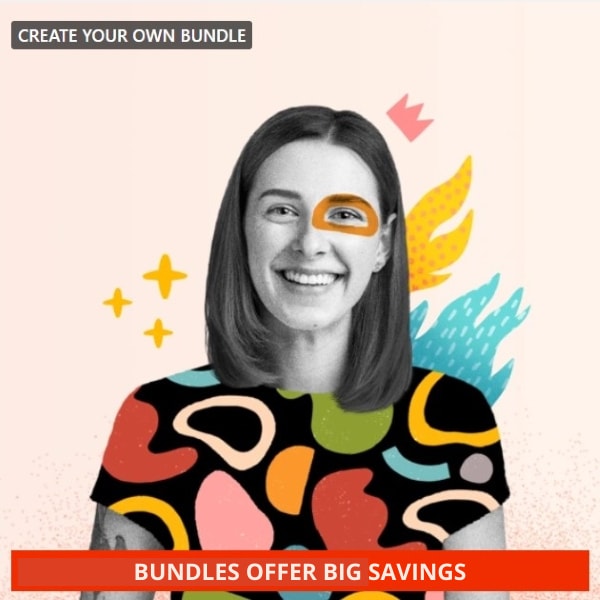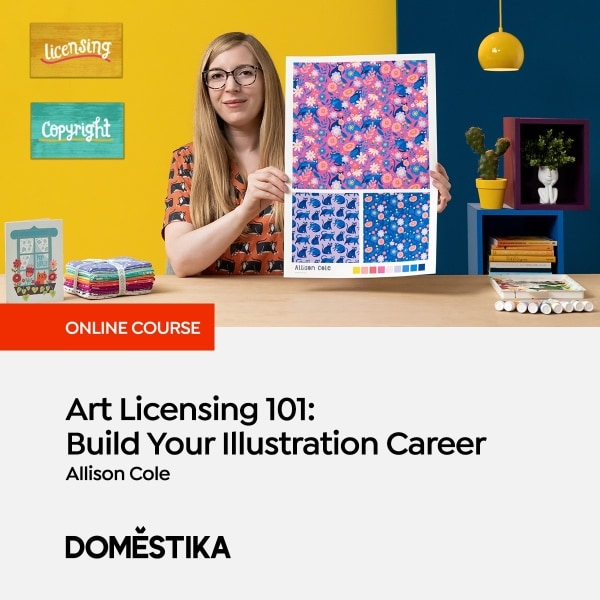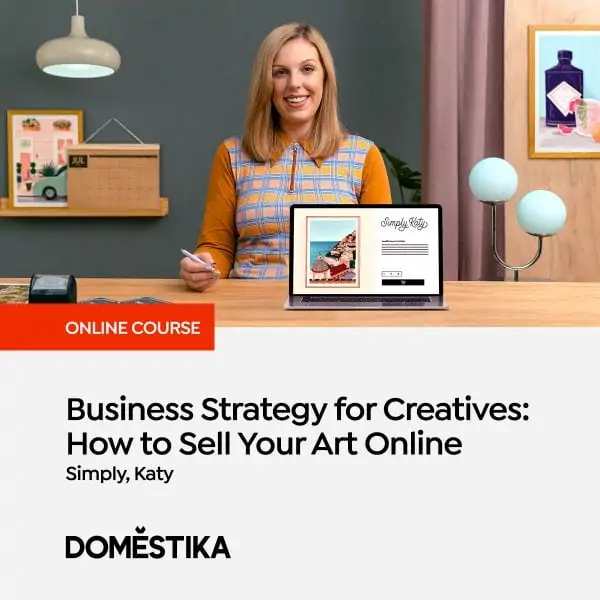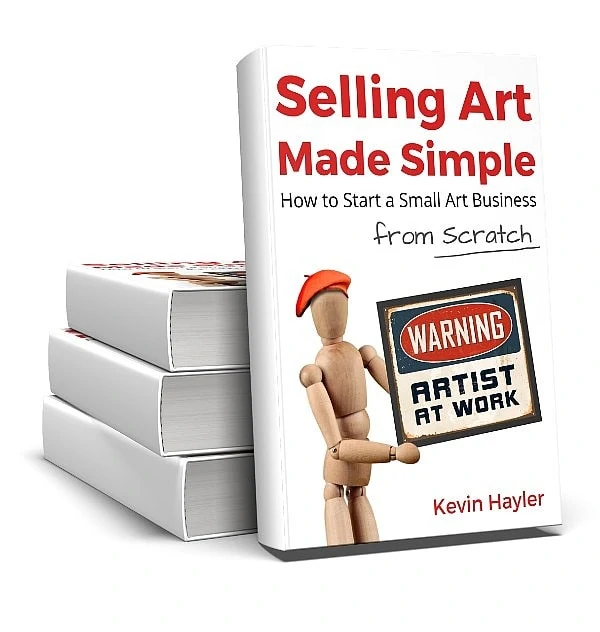Kevin Hayler: Professional Wildlife artist, author, and traveler.
For many artists, the idea of making a living from their art is a pipe dream. The good news is, with the internet, there are more opportunities than ever to make money as an artist. So if you are serious, here are 19+ ways to make money as an artist.
I have a lot to say under each heading and if you can’t find everything you need, I’ve included links to point you in the right direction. Skip to the parts that interest you most.
So, let’s crack on because this is a long read.
Disclaimer: When you buy something via my affiliate links I earn from qualifying purchases and sometimes earn a commission, at no extra cost to you. I am an Amazon Associate among others. I only recommend trusted sites.
1. Make Money with Art Commissions
The easiest way to make money as a beginner is through art commissions. In the beginning, most artists are hired by friends and family and then by word of mouth. Typical commissions would be family portraits and their pets.
It’s a great way to get started but to make money you will need to take it further. Use your social circle as ambassadors and recruit them to promote your work. The idea is to get the ball rolling.
There’s good money to be made if your art style is quick and you’re in the right ‘set’. In other words, if your potential clients are affluent.
If not, you should target wealthier clients by specializing in painting and drawing their passions and interests. It’s all very well painting your neighbor’s ailing cat, but if you can do the same thing for someone who’s wealthy, you can charge much more for the same amount of work.
As a way in, and without contacts, you should advertise your services. Rent a booth at a dog show, a pony club event, or at a regatta. Go anywhere the money is. Your costs will be higher but so will your returns.
Follow my advice in this post: How to Get Art Commissions The Easy Way and Make Money
Often overlooked, murals are another way to make money. They are not confined to nurseries or playgroups, at the higher end, leading brands will commission them for advertising.
Start with a portfolio of designs, either previous work examples or mockups of your designs, that can be scaled to size as commission.
Who would commission a mural? First of all, there are the more obvious places such as nurseries, schools, surgeries, and hospitals. Then there are restaurants, hotels, and bars.
Private commissions from soon-to-be parents eager to decorate their kid’s rooms could be lucrative. Interior designers might commission you, it’s worth presenting your portfolio and networking.
Then there are small businesses. Think about all those depressing graffitied walls blighting every town. Think how upsetting it is for any business owner to have to live with that on their own walls.
It wouldn’t take much persuading to convince the owner that your mural would not only make life better but also act as free advertising. The local press are always looking for local stories and something as big and bold as a public mural is a good way to get exposure.
The mural can be themed to the business. and it’s tax-deductible, what’s not to like?
Think how tempted a business would be if you guaranteed to keep the mural in good repair for the first year to prevent taggers from spoiling it. If you go the extra mile, you should get the business.
2. Teach Art Classes or Workshops
If you have a passion for art, confidence, and some talent to back it up, teaching art classes or workshops is another great way to make some extra cash or even a full-time living.
An easy way to get going is to find a cheap rental space to host the venue, advertise your services on notice boards and local Facebook forums, and charge a fee for every attendee.
Limit the class size to create urgency. I knew a woman who offered watercolor workshops this way, and to be honest, what she lacked in skills she made for with enthusiasm and personality.
She was making £1000 ($1100) per week 20 years ago.
Successful artists think outside the box and sell themselves.
This post will open your eyes: Make Money Teaching Art Online and Off: The Pros and Cons
3. Make Money Teaching Art Classes Online
If you are anything like me you are reluctant to show your face online. I have difficulty being in a photo, let alone being on video. However, there are big bucks to be made and I’m procrastinating. This is one of the best ways for independent artists to make money.
How to Make Money as an Artist on Udemy
To make money as an artist on Udemy, you’ll need to create an online course and market it to potential students. Your art course should be well-organized and cover a specific topic or skill.
You can promote your course through Udemy’s marketing tools, social media, and Youtube.
Some course creators make a lot of money on Udemy, while others make a significant extra income.
It must be said that as a buyer, Udemy courses are hit and miss, but that leaves the door open for anyone who is willing to put in the extra effort and make a professional course. That person will be you of course.
As it is, it’s a platform where you can test the water and give it a go. Udemy courses are sold on a pay-as-you-go model. The course creator sets their own price and Udemy takes a cut.
How to Make Money as an Artist on Skillshare
Skillshare is also an online teaching platform but one that specializes in creative courses. If you want to learn some new artistic skills, Skillshare has plenty to offer and like Udemy it has an open policy for course creators, meaning anyone can make a course and get paid for it.
Not only is Skillshare more relevant for creatives, but it’s also more concerned with the quality of the teaching. The overall standard is slightly higher than Udemy.
You can also promote Skillshare’s online courses to your audience through affiliate links, as I do. If you haven’t got to the stage of making your own course, there is nothing wrong with promoting someone else.
I have noticed that a handful of course creators get most of the traffic. Invariably they have superb ratings, so the emphasis is on reputation. They also promote ‘staff picks’ for useful courses which will help newbies.
Skillshare has a yearly membership business model and students pay $168 (2022) for access to every course. Teachers are paid from a royalty pool, and it’s calculated based on how many minutes of watch time each course generates each month.
How to Make Money as an Independent Artist on Domestika
You may not be familiar with Domestika and for good reason. It was formally a Spanish site with Spanish-speaking courses. It’s now based in the States and actively promoting English-speaking instructors.
Domestika is a step ahead when it comes to quality. Their classes are produced to such a high standard, that I promote their classes on my website in my online course section.
Take a look if you like, visit: Online Courses
Most tutors are still Spanish-speaking, but they all have auto-generated English subtitles. Don’t be put off, if you’re confident that you can meet their high standards you should give it a go.
Domestika is big and its top teachers have huge audiences. If you are equal to the top Spanish-speaking teachers and can make an English version, there’s a fantastic opportunity there.
Domestika sells discounted pay-as-you-go courses and takes a small commission.
Join as a creator, or take a look at the courses on offer. There are no membership fees.
How to Make Money as an Artist With Teachable
is an all-in-one platform that enables course creators to build and market their own courses from scratch.
They have all the resources you need to help you get going with tutorials on every aspect of production and marketing.
According to their website, they have over 100,000 instructors and listening to a webinar last night (not Teachable), I heard a claim that 4 out of 10 Teachable instructors earn over $50,000 per year. Is that a fact? I dunno but there is a great opportunity to be had, that’s for sure.
The price tiers, per month, as of 2023 are:
- Free
- $39 – Basic
- $119 – Pro
- $199 – Pro+
In other words, you can set up your course for free and dip your toe in the water when you are ready. They claim that the $99 tier is the most popular, maybe, but I can’t see many advantages over the $29 plan.
is another popular course builder, very similar to Teachable
Their price tiers, per month, as of 2023 are:
- Free
- $49 – Basic
- $99 – Start
- $199 – Grow
I don’t know so much about Thinkific, but a quick comparison suggests that you get more bells and whistles with the cheaper Teachable plans.
There is one more option I’ll mention briefly.
Podia is a great option for some folks:
Their price tiers, per month, as of 2023 are:
- Free
- $39 – Mover
- $89 – Shaker
I have never used Podia myself but it is the recommended teaching platform suggested by ‘Income School’ a premium blogging course that I use.
Make Money as an Artist and Join Linkedin Learning
(formally Lynda) has a huge range of courses geared at teaching students at every level, by professional instructors, with experience and qualifications.
Their courses are sold at a premium with a membership model at $29 per month. That will certainly filter out the dreamers.
It’s difficult to say how much a teacher can earn because royalties are paid according to the popularity of your course. Some teachers undoubtedly make big bucks.
4. Make Money with YouTube Art Tutorials
A YouTube channel has the most potential for getting quick results. It’s still a growing platform with a low bar of entry. The thing about YouTube, something Facebook and Instagram have abandoned, is the amazing organic reach.
If you make video content people like, you will rise to the top and not be outranked by the big boys or advertisers.
Art lessons on YouTube attract huge audiences and a loyal following. YouTube provides a great platform for talented artists to share their knowledge with a wider audience for free while earning a great income.
I follow a guy called Dries Ketels on YouTube. He doesn’t get a huge following, at the time of writing it’s only 13.4K, yet he revealed, that with only the views he gets now, from publishing one video a week, he earns $800 per month from the advertising revenue alone!
That’s not including referral and affiliate links.
And here’s the thing, he only talks about art and making money, he doesn’t even do art tutorials.
Now check out Kelsey Rodriguez and just imagine her income from over 200,000 followeres! The video below has almost a million views.
There are a lot of artists and tons of different art tutorials on YouTube, and many of them attract enormous audiences. Most of them, but by no means all. have very modest artistic talent. Incredible.
There are two main ways to make money with your YouTube channel. You can run ads (after a minimum of 1000 subscribers or 4000 watch hours in the last 12 months) and also promote your affiliate links in the description.
The other way is to use your videos as teasers and direct your audience to your website, Etsy store, teaching course, or Patreon site.
You don’t have to appear online if you don’t want to, we’ve all seen those speeded-up videos where a work of art appears magically in seconds. They hypnotize viewers and yet teach you nothing, that’s a classic teaser.
You can do the same kind of thing on TikTok. Try giving 60-second tips and driving viewers back to your site for more of the same.
You can also rank high on Google searches with YouTube and beat the blogging competition. If you want more visitors, write great blog posts and embed your YouTube videos covering the same subject. It’s a simple way to get a boost in your rankings and more ad revenue.
5. Sell Print on Demand Merchandise
Print-on-demand drop shippers print your designs onto a variety of products and ship them directly to your customer. This can be a great way to make some extra money. It sounds easier than it is. It’s not passive income because it’s marketing that will drive your sales and that takes time and know-how.
The secret to gaining sales is to produce commercial designs in quantity. This is no way to sell fine art. Think in terms of phone cases, mugs and Tee-Shirts.
Very few people manage to make a full-time living this way, and the profit margins are low, but many artists use print-on-demand services as a lucrative side hustle.
Top tip: Increase your income by offering merchandise as an upsell for art commissions. Think who else would love a print of your art commission and push the idea as a unique gift. This is an art business, you’ve got to think this way.
Other well-known Print-on-Demand sites include:
- Printful (recommended)
- Printify
- Fineartamerica
This post will interest you: Is Printful Worth it? Print on Demand Review (2023)
6. Be an Artist in Residence
Being an artist in residence is a great way to get your artwork in front of a captive market. By being in residency at a specific location, you are able to create a body of work that is tailored to the audience.
For example, if you make wildlife art, as I do, a zoo residency makes perfect sense. What better place could there be to promote your art?
I knew a guy who was Artist in Residence in a large hotel, He sold local landscapes, which was ideal.
The location doesn’t have to be high-end and arty, all you need is the footfall and the right kind of people for your style of work.
7. Make Money in Art Fairs and at Festivals
The best art fairs and festivals are the ones that attract affluent art lovers already interested in buying art. These events are typically well-organized and offer a wide variety of art for sale.
There are drawbacks however, popular events are booked out well in advance and booths cost a lot of money.
Quite apart from the event fees, there are logistics to take into account too. If the festival is far from home you must factor in transport and accommodation.
But you’re not confined to art and craft fairs, sometimes it’s better to attend a different kind of event and be a bigger fish in a smaller pond, as it were.
If you are doing an art fair read these:
- How to Sell More Art: 10 Top Selling Tips for Artists
- Who Buys Art and How to Spot a Buyer? (Secrets Revealed)
- Artist Business Cards: How to Use Them to Drive Sales
As long as you target shows and festivals that relate to the style and subject of your art, you can make better money. With only a few artists in attendance, you can get a bigger slice of the pie. Who needs competition?
In my experience, it’s better to have a smaller targeted audience that is interested in what you have on offer than a big audience of casual random people. That’s especially true of free events.
Think about it, if something is free it attracts people with no money to spend. It’s as simple as that. If that free event involves partying, don’t bother selling art, it won’t work. I know from experience.
Then there are weekly art and craft shows. Regular markets are a double-edged sword. In some respects, it’s good to be the fixture who is reliably there every time, but on the other hand, you may well discover the law of diminishing returns.
As a seller, you soon realize that attendees are there for something to do on a weekend. A new artist can do well at the beginning, but without a turnover of new faces, the interest can wither on the vine. It figures, there are only so many pictures people will buy.
Local fairs are a good option if you can get in on the Christmas trade or you’re looking for commissions.
There is something to be said for attending more exclusive art fairs. If a customer has to pay to get in, even a token amount, it filters out the dust-kickers. Only customers with a real interest will pay up. You really have to be an enthusiast or an art buyer to do that.
8. License Your Art For Passive Income
Licensing art is one of the best ways to generate passive income. By licensing your art, you are essentially selling the right to use your artwork to another business.
That person can use your artwork on a product they are selling, on agreed terms. You typically sell the rights for specific usage and for a limited time period. When it comes to an end, both parties can re-negotiate terms.
This approach is not for fine artists who want to say something to the world. It entails painting commercial subjects, in a style and size that will reproduce on a wide variety of products.
If you are a graphic designer, licensing your work is a wise move.
These posts will help you:
If you are anything like me, licensing is hard to get my head around, how do you know people aren’t ripping you off? I don’t know all the answers but I know where you find can find out.
If you need some help with licensing and what it’s all about, this is a popular course by Alison Cole on Domestika
9. Join Patreon and Attract Patrons
Patreon is a Godsend for many artists. The site provides a platform for artists to offer masterclasses in return for exclusive access, which can be tiered at different price points.
A basic mentorship tier might involve general tutorials and advice open to all, the next level up could be personal private masterclasses, and the next tier could be personal one-to-one coaching. That’s how it works, with variations to suit your circumstances.
The payments are monthly and can be canceled at any time, but psychology dictates that most mentors are reluctant to unsubscribe too soon.
Read this post and find out more: Is Patreon Worth it? What You Should Know in 2023
In theory, there is no reason why you can’t pay for a month, find your information and leave. In fact, most people stay for a few months. I know I did.
I followed someone for 6 months and paid $10 each time. In effect, I paid $60 for the info that intrigued me. When I left I felt disloyal. It was quite hard to do.
The key to making Patreon work is to provide great value in return for your patron’s donation. Giving people direct access to you via live video and meetups is a real winner.
10. Sell Your Art on the Street (Sidewalk)
I’ve been trading my art prints for 20 years on a public street in a seaside resort, and I know there are a number of ways to make money selling art on the streets.
.It’s a seasonal trade but even so, I earn enough money in the summer to carry me through the whole year. Don’t underestimate the earning potential of street trading.
It is HUGE!
The public thinks you’re a starving artist selling themselves short, but they don’t know how much money street traders make, and if they did they wouldn’t believe it.
To make this work, you need to sell prints and learn how to sell them like a market trader. It’s a mindset shift. To passers-by, your art prints are just stuff and to make them special you must leverage your unique selling point, namely, that it’s your own artwork.
Read this post for more info: How to Sell Art on The Street: By a Street Artist
I attract custom and prove that I’m the real deal, by drawing in front of everyone. It’s my sales hook if you will. I sell the romance of my lifestyle combined, with collectible subjects, in a traditional art style.
This stuff works
The other classic way to earn cash on the street is by doing portraits. It’s a skill few will master, and it’s only for the blessed few. A more viable alternative is to make caricatures.
There are quite a few caricaturists in my home town and most of them are mediocre or failed portrait artists, but they make a good income. It’s very downmarket but as a summer job, it pays the bills.
Another option is to paint local landmarks. Local views and famous sites are perfect as tourist souvenirs. The drawback, artistically, is painting the same views over and over again.
It’s better to copy what I do and make prints. Have one work in progress as a prop to entice onlookers, and sell prints for a living.
The biggest stumbling block is permission to trade. Some towns are strict, while others are more relaxed. Luckily, artists have an advantage, everyone thinks we are charming and poor, so they cut you some slack.
Milk it for all its worth!
11. Sell Your Art in Open Studio Events
Some artists make a good income by opening their homes/studios to the public in Open house events. Many towns organize these very popular gallery trails at various times of the year.
They tend to be very well advertised and people will come from far and wide to tour the artist’s home.
There’s a gallery trail in my hometown, in fact, as I write my friend is preparing his studio for the Spring Arts Festival starting this weekend.
Let’s not fool ourselves, half the appeal is to see inside other people’s houses, that’s a given, but everyone who walks the circuit has an interest in art, or they wouldn’t bother.
In other words, visitors have a buyer’s intent. They are not random onlookers.
A few visitors will actually be looking for original work and that’s great, however, most will be art admirers and open to impulse buys. They’re not looking to spend thousands, far from it, it’s a nice day out BUT they can be tempted to buy if the art is affordable.
That will probably be your best source of income.
Sell high-quality reproductions of your artwork. You’re not confined to selling limited editions, open editions are a great source of income. I’ve made most of my money selling signed open-edition prints.
Then there are the peripherals, cards, coasters, tiles, calendars, fridge magnets, that kind of thing. If licenses allow, you could even sell coffee and cakes, why not?
12. Sell Your Art in Galleries
If you asked the public where they would go to buy art, the chances are they would say in a gallery, but that’s not what they actually do. Very few people visit galleries.
Galleries cater to a tiny demographic, albeit one with money. Most artists, starting out, will be wasting their time. That’s not to say you can’t earn money, you most certainly can. If you do the type of art people want, and quickly, there is every possibility that you can get a return.
It’s unlikely that one gallery will provide you with enough sales, you’ll need several galleries in different towns or regions to get a good enough income. Plus it’s wiser to spread your bets and not rely on one gallery owner.
I sold my art this way years ago, it’s a lot of work and not something you can do casually. My advice remains the same, sell prints. It’s the only way to scale your business and get your art in enough places.
Read this post for a reality check: How to Sell Your Art in Galleries: Is it Worth it? The Truth Told
13. Use Online Art Galleries to Sell Your Art
If you’re a freelance artist looking to make some money from your artwork, selling through online galleries is a great option. There are a number of different galleries to choose from, each with its own strengths and weaknesses.
Some sites are open to all while others like Saatchi Art are selective and focus on selling original artworks. The important thing is to find a gallery or platform that fits your style of work and serves your target audience.
Etsy is one of the most popular online marketplaces for creatives. There’s nothing stopping you from opening your own online store and selling physical art prints or drop shipping.
There are alternatives:
I’ve even done well in the past selling prints on eBay
There are also online art galleries that focus on contemporary art forms. Digital artists can sell their art on sites like Art Station. Check it out.
Some galleries have juried submission policies in order to maintain the high quality of their offerings. These are 4 notable examples:
I won’t write any more about them here, namely because I’ve already done that.
- 25 Platforms for Artists to Sell Their Art Online and Make Money
- 6 Best Places to Sell ORIGINAL Art Online
- Is Selling Art on eBay Worth it? Pros and Cons for Artists
14. Sell Your Art From Your Own Website
Having your own website is a no-brainer. For the sake of about $100 a year for hosting and a domain, you can promote yourself in any way you please. Your website is like a hub for your business and everything should link back to it, like the spokes on a wheel.
You can open your own gallery to sell art online for free. You can sell prints, merchandise, downloads, and your own original artwork. If you use Woocommerce the open-source free plugin, all the profits are your own, why give money away?
You can also use your website to blog about your art, show your works in progress, and promote upcoming events. It’s all free.
If you want to set up a fully functioning and free e-commerce site for yourself, it’s perfectly possible without being techy.
It’s very easy to download Woocommerce, a free plugin, and set up your own e-commerce store in an afternoon. I set up my own Woocommerce store simply by following instructions on Youtube.
Occasionally you’ll have updates to enable, in the same way, that you have App updates. I’ve never had a problem.
Still need convincing? Read these:
- 11 Best Reasons Why Artists Need a Website in 2023
- Should Artists Have a Blog? Art Blogging Pros and Cons
- How to Start an Art Blog and Make Money for Beginners
If that’s a step too far, let people buy with Paypal, it’s easy to set up.
Open a PayPal account, and include a “Buy Now” button on your website. When someone clicks on the button, they will be taken to PayPal’s website, where they can enter their payment information. Your customer can pay with their credit card without signing up for a Paypal account.
Once the payment is processed, you will receive an email notification with the customer’s address and contact details, and the buyer will receive an email with a receipt. Simply post their item and you’re done.
If you are selling downloadable prints the receipt can contain a link to download the artwork.
The real beauty of having a website is the control it gives you to promote yourself, monetize your site with ads and affiliate links, and collect emails for marketing purposes.
15. Use Affiliate Programs to Sell Your Art
The classic way to earn money through affiliate links is to write popular blogs that get plenty of readers and have offers directly related to the content. Each referral earns a commission. Affiliate marketing can generate multiple income streams.
Sometimes the commissions are good, but realistically, most art supplies offer modest commissions. That’s not a problem, many small commissions soon add up.
Services and software pay more. Some offer recurring income.
Affiliate opportunities include:
If you’re an artist looking to sell your own artwork, one way to do so is by setting up your own affiliate programs with similar websites. This way, every time someone clicks on one of your affiliate links and makes a purchase, you earn a commission.
Most artists will go the conventional route because it is so much easier. The hardest part might be getting accepted onto affiliate sites. Unless you have some traffic, many will turn you down.
Notable affiliate sites include:
Don’t despair if you are turned away, all is not lost, there’s another way.
Skimlinks acts as a broker. They have access to most of the affiliate offers you will want to promote. You can join a program via Skimlinks and they’ll take 10% of the commission. What’s more, when you eventually join an official affiliate program it will override Skimlinks so you get the full rate.
If you have a young site and have yet to build a following you’re missing out on free money!
Amazon will sign you up easily but they’ll delist you if there are no sales within 180 days, not that it matters because they don’t stop you from reapplying.
You can use your affiliate links elsewhere. You’re not confined to your blog. You can add them to social media posts, notably Youtube, and pop them into bulk emails, for example.
Google Adsense is easy to join but pays pennies. It’s hardly worth the bother for most site owners. You will be better off joining Ezoic. They will accept low-volume sites and they have good customer support.
When your site gets to 50,000 visitors a month you can join Mediavine for a much higher return.
Read this article for more information 45 Affiliate Programs for Artists: Mega Guide (2023)
16. Sell Your Art through Email Marketing
Email marketing is one of the most effective ways to sell your art. By building a list of potential customers and sending them regular updates about your work, you can create a steady stream of sales.
Here are some tips for using email marketing to sell your art:
- Start by building a list of potential customers. You can do this by collecting email addresses at art fairs, galleries, and other events. You can also ask your current customers if they have any suggestions.
- You can collect email addresses through a sign-up form on your website. Use the side banner and put a form on each blog. If you are keen to build a list quickly, put three forms on your blog one at the top, middle, and end, preferably with a giveaway offer in exchange.
- Send out a monthly newsletter to your list of potential customers. This newsletter should include information about upcoming events, new products, and special offers. You can also use this newsletter to promote your own art, digital products, and courses and reach out to other bloggers to promote their goods and services for a commission.
- Post consistent and regular updates. This will give you an opportunity to share your knowledge and expertise with your potential customers, build their confidence in you, and retain subscribers.
It’s worth mentioning that an email list is your biggest asset. You are at the mercy of all the other 3rd party platforms with their changing algorithms and policies and your business can tank overnight. Your list stays with you.
Read this post: How to Start an Email List For Artists: Beginners Guide
17. Use Social Media to Sell Your Art
Social media is a broad term but there are notable social media platforms that are popular with artists, namely Facebook, YouTube, and Instagram. Once you have an account, you can start sharing your artwork and building a following.
You can also join Facebook groups related to your niche, join in discussions, and get your name out there. This will allow you to network with fellow artists, build relationships and follow leads.
How to Make Money as an Artist on Facebook
In truth, Facebook has never had 100% organic reach but now it has dwindled to almost nothing. In 2021 it was down to just 2.2%. But that doesn’t mean you can’t use Facebook to build your business, it means you will have to use Facebook Groups to get any traction.
Like all social media platforms, Facebook is a great place to build relationships with your audience and it’s worth taking the time to answer their questions. If you can provide the answers, it gives you authority and users will start to listen.
It can take time, but if you do it properly, you’ll be rewarded. Eventually, you can nudge them toward your website. Keep to the rules, you don’t want to get kicked out, but be subtle. The emphasis must always be on helping people out.
If you have something to sell you can always ask the moderator and offer a share of the sale.
Facebook is an excellent way to stay in touch with your customers, especially for service-based businesses.
This post will help you more: Social Media For Artists: The Best 13 Platforms for Creatives
How to Make Money as an Artist on Instagram
There are a few ways to make money as an artist on Instagram.
The usual way is to post your artwork and include a link to your website in your bio.
Instagram (owned by Facebook) doesn’t encourage its users to leave the platform so they limit your links. Many Instagrammers use Linktree to send viewers to a choice of URLs. It helps, but it’s still very hard to get someone to make the first move.
You have to post excellent images To get noticed on Instagram and do it consistently. Your post has a very short lifespan, you have a very brief opportunity to be seen, even by your fans.
So given the drawbacks what are you to do?
You can pay for ads which is what Mark Zuckerburg wants you to do and almost inevitably you’ll lose more money than you’re likely to earn, or you can use it to target buyers in a sneakier way.
Find the galleries that sell work similar to your own, and follow their followers. You can be sure that many of them are former buyers or potential buyers. Comment and get to know them using the back door. Simple.
This post will help: How to Promote Your Art on Instagram: Tips For Artists
One other way to get some attention is by running contests and giveaways and obliging your contestants to comment, hit the like tab, and visit your site for the chance to win or get a freebie.
The results can be announced with a link back to your website. You can make a dedicated landing page with the names of the prize winners and carefully crafted special offers, and affiliate links.
18. Making Money as an Artist With Crowdfunding
Crowdfunding is a viable way for artists to make money. Kickstarter is the most well-known crowdfunding site, but there are others. Indiegogo and GoFundMe are very popular.
You can set up a campaign to fund your art project, and if people like your project, and you market yourself well, the public can pledge money to help you reach your goal.
If you have a large email list you can use them to help launch your appeal. Send out a message and offer a really great deal in return for a basic pledge to get the ball rolling.
The platform will pick up on all the interest and promote your pitch.
It is very important to get your video production spot on if strangers are going to be captivated enough to pledge their cash. You can’t cut corners on the presentation.
If you have a great idea unlikely to get commercial backing but would excite an audience, crowdfunding is definitely an option.
It involves a lot of work and it’s not for the fainthearted, you will have to:
- Devise a great title as the hook
- Make a compelling video
- Set a clear unambiguous goal
- Tell your backers why you are raising funds
- A cost breakdown
- Figure out gifts in return for their donations
- Send out progress reports with links to your website
19. How to Sell Your Art on Etsy
Etsy is a huge online marketplace with over 2.5 million sellers, so you’ll be a very small player with enormous competition.
If you’re an artist looking to sell your work on Etsy, there are a few things you need to do in order to succeed.
You must niche down and compete in less competitive markets and be willing to put in the work required to stand out from the crowd.
This post goes more into the pros and cons: Is Selling on Etsy Worth it? Pros and Cons for Artists and Crafters
To niche down, you need to focus on a specific target market. This can be done by narrowing your product offerings to a specific:
- Style,
- Genre,
- Theme.
Once you’ve narrowed your focus, you need to create a brand around your niche. This will make it easier for potential customers to find your work and understand what you’re all about.
And that’s not all, your art must be commercial. Etsy promotes itself as a platform for artists, crafters, and creatives, but essentially it’s just a retail outlet with e-commerce at its core, and shareholders to satisfy.
That means you must research the market and make what the market demands. It doesn’t work the other way around, not unless you’re very lucky.
Don’t confuse quality with saleability, sadly the two are not one and the same thing.
Etsy is in the top ten websites in America, consequently, that’s where most of the customers come from. Fine if you’re North American, but not so fine elsewhere.
I’ll give you an example. I had an Etsy shop selling my art prints, here in the UK. I did nothing to promote it, but I got sales every now and then and I treated it as passive income.
If you sell downloadable art prints (printables) you can circumvent this issue.
Use Etsy as an added side-line. It might generate a good return, some people do very well but don’t rely on the platform. One algorithm change or hike in fees and your business can take a tumble.
That happened to me on eBay for similar reasons. Be warned.
How to Make Money as an Artist: Final Thoughts
Freelance artists have always had to find creative ways to make money from their art. In the past, this meant finding a patron or selling their work through galleries. Now with the rise of the internet, the art world has opened up for artists with more opportunities to make money than ever before.
If you’re committed to making art as your full-time job, it can be done, but don’t be fooled into thinking there’s an easy way, it’s hard work. Even passive income involves a lot of work before any money starts to roll in.
Making art for money is a business, with no guarantees, but those prepared to put in the hours, are the artists most likely to succeed.
Good luck.
Get Organized with a Structured Course on Domestika
I know more about selling art face-to-face from a market stand than anything else. I can tell you how to start up a small art business from scratch. Interested?
If you want to dig deeper into selling your art, check these posts out:
- Can You Copy Art and Sell a Painting of a Painting? I Found Out
- Is Selling Art on eBay Worth it? Pros and Cons (2023)
- How Do Wildlife Artists Make a Living? Copy This and Get Started
- How to Make Money With Digital Art: 10 Ways to Profit
- Selling Digital Downloads on Etsy: Best Guide in 2023
- How to Start a Printables Business: A Beginner’s Guide
- What Size Art Sells Best? Frames and Apertures – FREE Chart
- How to Sell Your Drawings: 10 Steps to Success
- What Kind of Art Sells Best? All The Secrets Revealed
- How to Sell Your Art and Travel the World (Psst…Do What I Did)
PIN IT AND SAVE IT
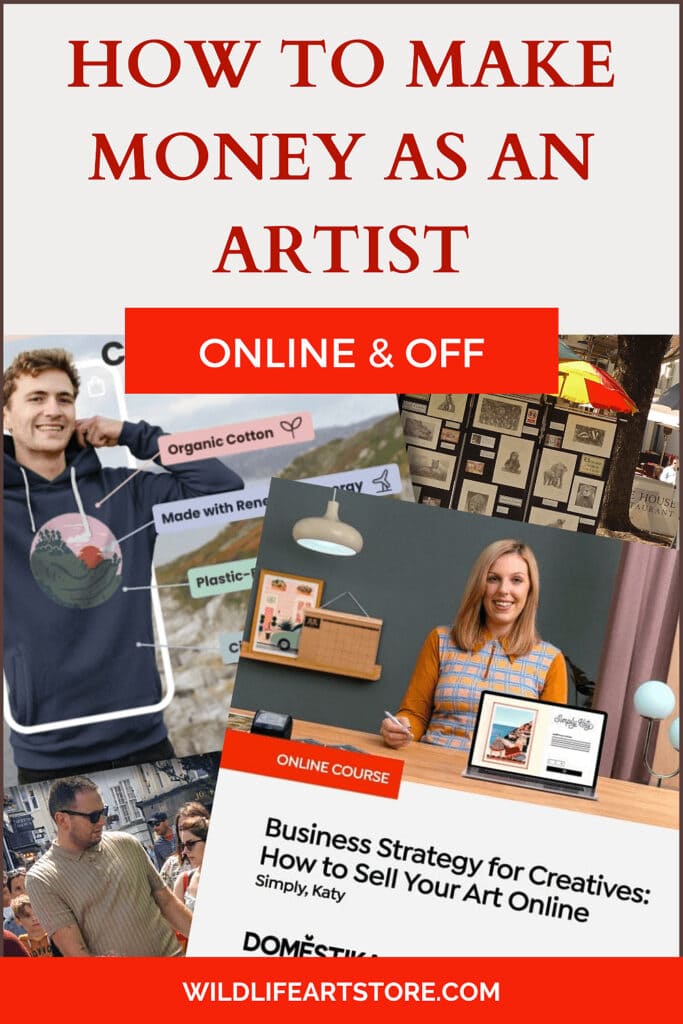

Hi, I’m Kevin Hayler
I’ve been selling my wildlife art and traveling the world for over 20 years, and if that sounds too good to be true, I’ve done it all without social media, art school, or galleries!
I can show you how to do it. You’ll find a wealth of info on my site, about selling art, drawing tips, lifestyle, reviews, travel, my portfolio, and more. Enjoy


